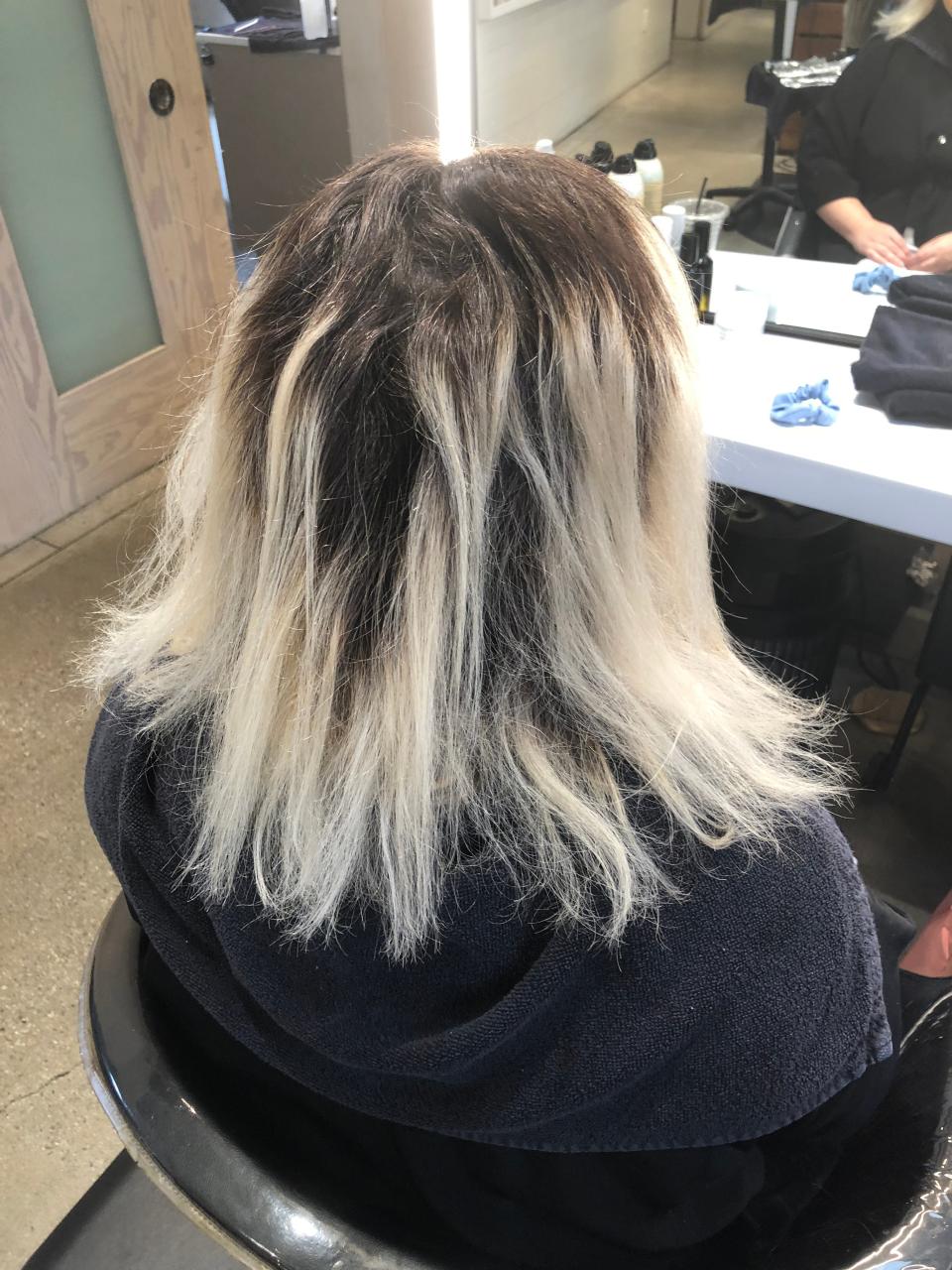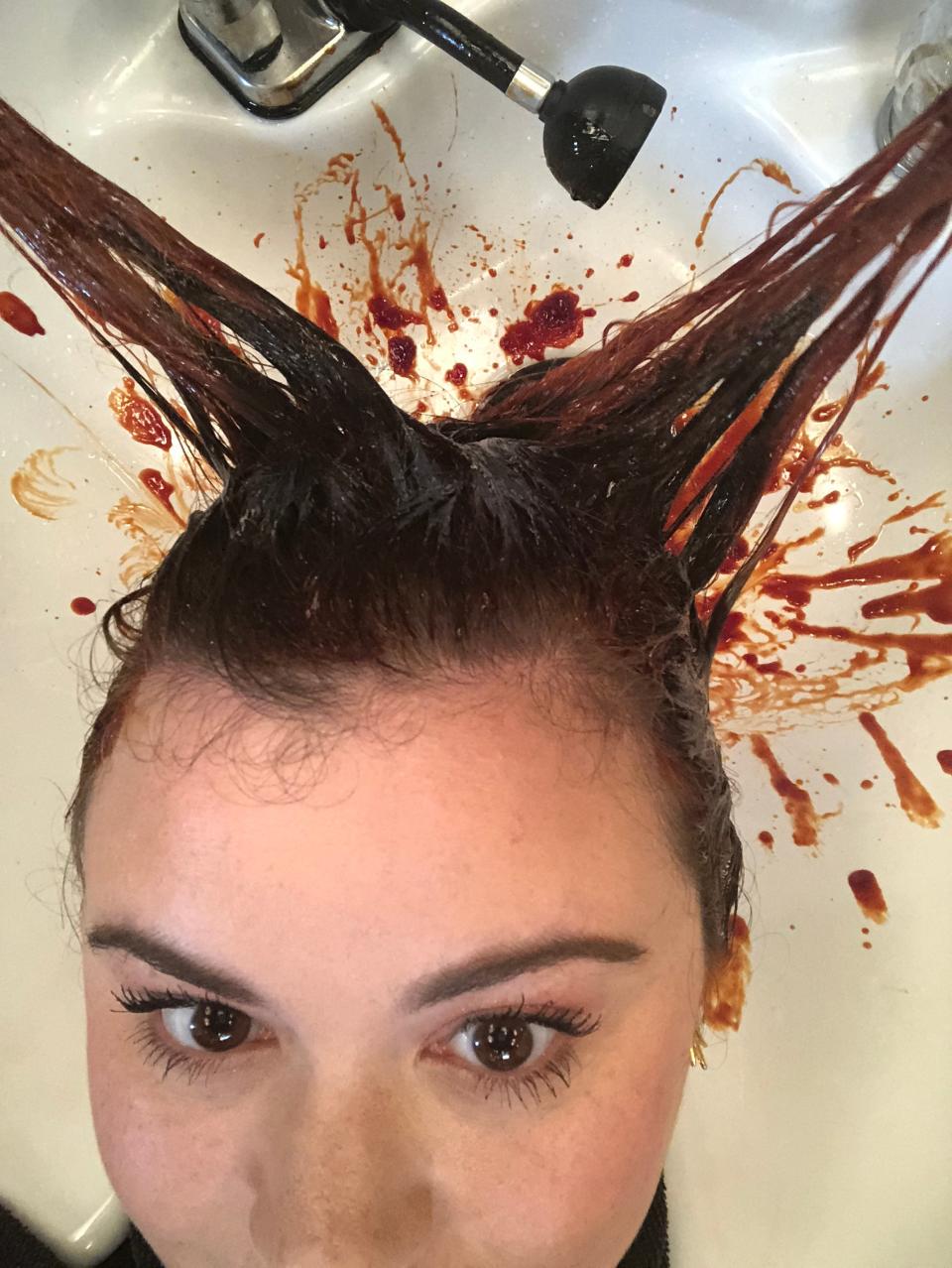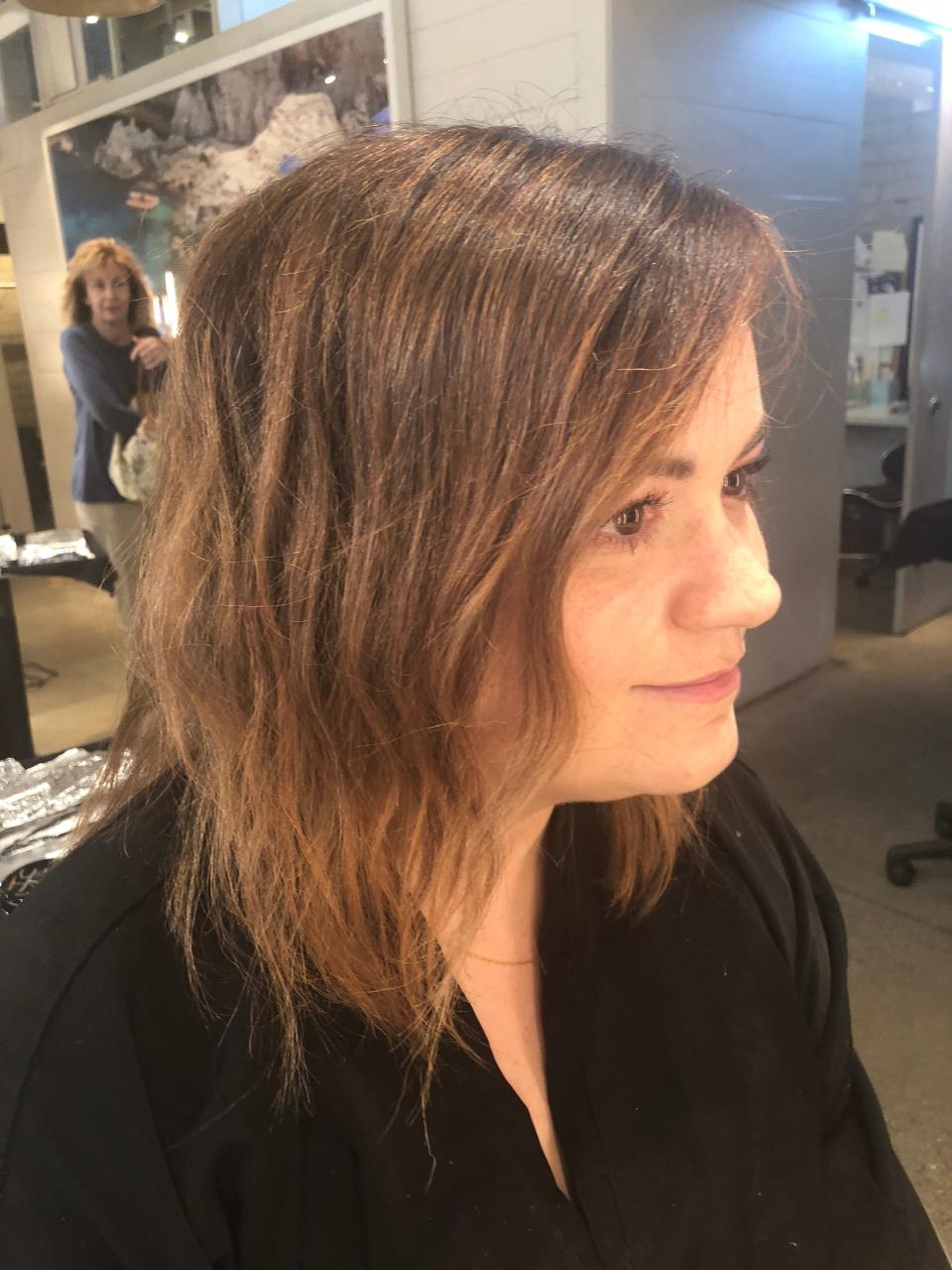Let My Hair-Breakage Disaster Be a Warning to Anyone Who Bleaches Too Much
CTA: Here's the lowdown on how to subscribe to Allure's print edition for more beauty routines, recommendations, and features.
I remember the first time I had a panic attack over my hair. No hyperbole here — I'm talking about a hyperventilating, need-some-Xanax-now-level panic attack. It was in eleventh grade, hours after I'd decided to take my dyed-blonde hair darker, because Jessica Simpson had lowlights. (It was 2002, OK?) I had been a bottle blonde for years at that point. My hair, which I straightened every morning before school, was a honey color back then.
Up to that point, I didn’t think I was emotionally connected to my hair. I never cared about getting it cut and would frequently chop off inches out of boredom. But there I sat in my then-boyfriend’s car, looking in the mirror and sobbing. I don’t remember if I actually voiced my feelings or just rushed back to the salon to get it fixed. But in that moment, I felt ugly. I needed to go back to who I'd been hours before, as quickly as possible. And I did. I calmed down, went back to the salon, and got a layer of highlights to hide the brunette shade mixed in. I remember looking in the mirror and breathing a sigh of relief. I was cute again.
Check out this month's Allure Beauty Box, which is packed with products hand-picked by our editors – all for only $15.
For years, I would play with hair colors. When I was broke and moved to New York for college, I dyed my hair darker but eventually went back to blonde. Let me be clear: I think dark hair is gorgeous. My hair is naturally a medium-brown color. My Instagram’s Saved folder is, and always has been, entirely brunette inspiration. I just never felt good-looking enough for the color. When I pictured brown hair and pale skin like mine, I saw Anne Hathaway and Keira Knightley. Since I didn't think I was as pretty as them, I assumed I couldn’t "pull off" a brunette shade close to my natural color. I acknowledge how ridiculous that is, but it was just one of the unrealistic expectations I put on myself, bowing down to society’s idea of beauty. (Or, probably more likely, to what straight men consider "hot.")
Fast-forward many years later, to when I was 33 years old and still on the blonde-hair grind. As a beauty editor since graduating college, I've had the privilege of receiving complimentary hair-color services, refreshing my platinum blonde strands every three to four weeks. I loved having white-blonde hair and the way it added edge to a simple outfit, and how it looked good even when I hadn’t washed it for days. But I hated the bleaching process, and my scalp hated it, too. My head was sore and full of scabs for days. Still, I took decent care of it with Olaplex in the shower and weekly moisturizing treatments. If I started seeing breakage, I would just cut off a few inches. For a while that worked. Until it didn’t.
The Disaster
For one touch-up sesh, I waited too long in between getting my roots done, and, as a result, my hair color wasn’t lifting. I promise I wasn’t just being vain going every three weeks — there’s a real reason you have such a small window. Generally, the hair closest to your scalp lightens faster than the rest of your hair, because your scalp gives off heat and speeds up the process.
"Bleach interacts with pigment in the hair in a chemical process called oxidation. This causes the release of the pigment, explaining how it lifts hair color," says New York City–based dermatologist Joshua Zeichner. "Heat may also be used, as it speeds up the oxidation reaction." So if you wait until your roots are longer than two or three centimeters, your roots will develop at two different speeds. Ever see a blonde person with a "band" of darker blonde near the roots? They had centimeters of hair that didn’t fully lift. That’s what happened to me. My scalp was white blonde, but I had a brassy band.
My hairstylist — an awesome friend and talented individual — was convinced she could remove the band by adding another layer of bleach. Double-bleaching is a common service, but it’s tough on your hair and scalp. Knowing how sensitive my scalp is and wanting to be safe, she suggested we wait a week between layers and do Olaplex treatments in between. Because she didn't want me sitting in a salon again that month, she came to my apartment armed with all the goods once it was time to bleach.
The rest of the night is a bit of a blur, but it went a little something like this: The layer of bleach went on the brassy section a little bit away from my scalp. We used a low 20-volume bleach so it had to sit on the strands for about 10 to 15 minutes. She instructed me to jump in the shower and rinse the bleach out, and then she would apply a toner.
And that’s when it happened. I’m in the shower gently rinsing when I start to feel chunks of hair falling out. I’ve always been a shedder, and I’m used to some hair in the shower, but these were handfuls of white hair that weren't coming directly from my scalp. I started to panic and called my friend into the bathroom. She calmly rinsed the rest of the bleach out but admitted that, yes, my hair was breaking off. Once I was out of the shower, she combed through my hair trying to find the damage. We found it was a pretty thick layer near the nape of my neck and I had about an inch of hair back there.

Not surprisingly, this was the same area where I tied my hair back, even when I slept. I wasn’t crying — I think I was just in shock. I wasn’t 16 years old anymore and I didn’t have the same insecurities, but I also didn’t think I could pull off a pixie cut. I was also trying to protect my friend. I'd been asking her to take me to this color for a long time, and I wasn’t doing my part to keep it healthy. Instead, I kept using hot tools on it and wearing it pulled back. I knew the situation was just as traumatic for her.
I was up until five in the morning watching YouTube videos and reading stories of people who had gone through the same thing. The narratives were similar: too much bleach left on for too long. Something had to give. Aside from being totally freaked out from the experience, I was embarrassed and didn't want anyone to know about my mistake. I blamed myself for my obsession with being blonde. I felt stupid that I'd let it get to this point when I knew better.
For the next few months, I did what I was told. I stopped blow-drying my hair and took to wearing braids and headbands to hide the frizz and damage. I babied my strands. I let my roots come in for the first time in years and did nothing about it. Even when they got really long (my hair grows annoyingly fast) and people asked what the hell was going on with my two-tone hair, I did nothing. My instinct was to run to a salon and dye it a "natural" brown color, but I was told by the best colorists to wait. The strands were too damaged and "gummy" to take the color well (that’s a term for when wet hair is sticky and prone to breakage). I waited until the hair underneath got a few inches long and people stopped asking if I had shaved it off. There were still sections that snapped easily, but within a few months, my hair was as good as it was going to get. At that point, I was nervous, but the time had come to get rid of the blonde.
The Fix
I searched for a trusted colorist and landed on Jacob Schwartz at Mèche Salon in Los Angeles. He's trained with Tracey Cunningham and worked on famous brunettes like Mandy Moore and Hillary Rhoda. Even though he’s way too kind to say it, I could tell he thought my hair was a big ol' hot mess. He explained what I suspected: Overlapping the bleach is what killed my hair. With strands as naturally dark as mine, it’s impossible not to have breakage. That’s why he’s seeing more and more people moving away from the bleach-and-tone life. He reminded me that celebrities like Ariana Grande and Kim Kardashian are wearing wigs or, at the very least, extensions to get that full-on white hair look.

We looked through brunette hair photos together and came to a decision to try a medium-brown shade. Part of me still felt like a teenager, worried I was going to look "ugly" with a darker hue. But I wasn’t a teen and this wasn’t the early aughts. It’s 2019 and there isn’t one type of beauty anymore. Really, there never was. The landscape is finally starting to change. Freckles are cool. Frizzy hair is cool. Being different is cool. I pushed down my insecurities and let Jacob work his magic.

The process took about six hours. When you’re super blonde, you can’t just grab a dark hair dye and pop it on. It’ll start off looking like a one-color wig and turn a muddy-green shade after a few washes. Bleaching removes each layer of color out of your hair. You have to layer it back in for your strands to look rich and shiny — you know, like real hair. This takes time and patience. Jacob broke up my roots with medium-brown highlights and filled the rest in with a copper shade. Then he layered highlights and lowlights, alternating back and forth until there was natural-looking dimension.
The Results
To the surprise of no one but me, I loved the finished product. It looked healthy and vibrant, like it had never been platinum. But just because it looks brown doesn’t mean it will act like my natural brown hair, Jacob warned me. It’s not like it became virgin hair in a day. I was given a weekly conditioning treatment, the Olaplex No.3 Hair Perfector, to use in the shower on alternate days, and Olaplex’s shampoo and conditioner to wash with every few days. He told me to grab the Gloss Moderne High-Gloss Masque to leave on overnight as needed. And he made me promise to keep coddling it by laying off the hot tools and coming in every three weeks for a gloss as it fades. Eventually, as my hair gets healthier, it will hold color better.

I’m not saying I’ll never be blonde again, but for now, I’m loving being a brunette. I thought I would feel invisible, but I actually just feel confident. Instead of playing around with color, I’m playing with hair accessories, new textures, and cuts. My skin looks brighter, and I’ve stopped covering my freckles. I even wear more color and prints now, which previously felt too showy before my new dye job.

I look at photos of my old hair and miss it, but only enough to try out a wig for fun — not to go through broken hair again anytime soon. My bleaching disaster definitely made me more aware of how I'm taking care of my hair. That said, you should color your hair in whatever way makes you feel good, but for me, I’ve found a quiet confidence in having a hue close to my natural shade. But what I previously thought was "boring" is really cooler than I'd ever expected.
More hair stories to check out:
Why It Matters That Retailers Are Finally Casting Models With Natural Afros
The Big Reason You Shouldn’t Bleach Your Roots If You Want Rainbow Hair
These Are the Best Purple Shampoos and Conditioners for Blondes
Now, watch Serena Williams try nine things she's never done before:
Originally Appeared on Allure

